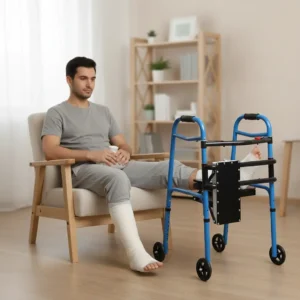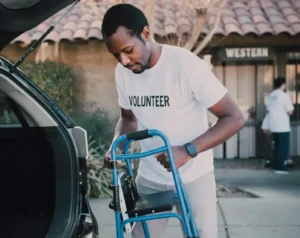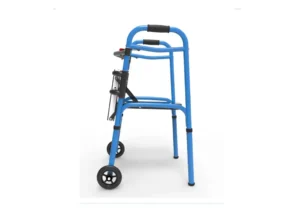Recovering from an injury or surgery can be a challenging journey, but having the right tools can make all the difference. Foldable walkers have emerged as an essential aid for individuals navigating the recovery process. In this post, we’ll explore ten compelling reasons why foldable walkers are not just practical, but truly transformative for those in need. Whether you’re regaining your mobility or enhancing your confidence, these walkers are here to help!
1. Compact and Convenient Storage
One of the standout features of foldable walkers is their ability to collapse into a compact size, making them easy to store or transport. This is especially beneficial for those with limited living space or those who travel frequently. Imagine a world where you don’t have to navigate around bulky equipment in your home or worry about space constraints when visiting friends or family. This portability allows for a smoother transition post-injury, letting you put your focus back on recovery rather than logistics.
Additionally, the ease of storage can prevent users from feeling overwhelmed by clutter. After all, recovering from an injury is challenging enough without the added stress of having to deal with unwieldy devices in your living area. A foldable walker can easily fit into a closet or the trunk of your car, allowing you to take it along wherever your recovery journey might lead.
2. Lightweight Design for Easy Maneuverability
Foldable walkers are often designed with lightweight materials, allowing users to push and steer them with minimal effort. This is a key advantage for individuals recovering from surgery or injury who may struggle with weighty equipment. Imagine carrying something as light as a feather rather than a heavy burden; this design feature significantly boosts confidence during movement.
Moreover, a lightweight design means that maneuvering through tight spaces or crowded environments becomes less of a hassle. It enables you to navigate your surroundings with ease, whether you’re in a grocery store, a crowded exam room, or even your own home. This autonomy serves a dual purpose: it not only provides physical support but also boosts emotional well-being by empowering users to be active participants in their recovery.
3. Enhanced Stability and Support
Most foldable walkers provide excellent support and stability, featuring wider bases and non-slip grips. This added safety helps users feel more secure as they regain their confidence in mobility. Stability is paramount; if you’ve ever felt wobbly or uncertain after an injury, you know how vital it is to have a support system that won’t let you down.
Furthermore, the design of these walkers often incorporates ergonomic features that evenly distribute weight, making it easier to maintain balance. Users can often walk further distances with less fatigue, significantly enhancing their quality of life. Knowing that you have that extra layer of security allows you to focus more on your recovery and less on the fear of falling or losing your balance.
4. Adjustable Height for Personalized Comfort
Many foldable walkers come with adjustable height settings, ensuring they can be tailored to individual users. This feature is crucial for proper posture and comfort during use. Think about how uncomfortable it feels to use an item that isn’t the right fit; it can lead to strain, discomfort, and even delay healing. An adjustable walker empowers users to find that perfect height, allowing for more effective and stress-free movement.
Additionally, as users progress through their recovery, having the option to readjust the walker can be a huge psychological benefit. You’re not stuck with a tool that feels like it’s tailored for just one stage of your healing; instead, it evolves with you. This adaptability not only fosters a sense of empowerment but also directly contributes to better posture and reduced strain on your body.
5. Versatile Options for Varied Needs
Foldable walkers come in a range of styles, some with seats or storage options, catering to different preferences and needs. This versatility makes it easy to find one that fits your specific lifestyle. For example, if you’re someone who enjoys being out and about, a walker with a built-in seat could provide moments of rest whenever needed. This feature allows users to take breaks without needing to find a bench or other seating arrangements.
Moreover, having the option for storage means you can safely carry essentials—like a water bottle, phone, or small bag—while you maneuver through your day. It makes the walker not just a mobility aid but a multipurpose companion as you reclaim your mobility, lengthening your active periods and enhancing your overall quality of life.
6. Aesthetic Designs that Don’t Compromise Function
Gone are the days of bulky, unattractive walking aids! Modern foldable walkers often feature sleek designs and appealing colors, allowing users to maintain their sense of style while recovering. Why should aid equipment be an eyesore? A well-designed walker can actually boost a user’s confidence while providing necessary support.
In today’s world, aesthetics matter; a walker that complements your style can enhance your connection to it. Choosing a design that resonates with your personality can transform the experience from merely functional to genuinely enjoyable. The right foldable walker can be a source of pride rather than just a tool during recovery.
7. User-Friendly Operation
Many foldable walkers are designed for easy operation, with intuitive mechanisms that allow users to fold and unfold them quickly. This ease of use encourages independence, a vital aspect of recovery. Imagine the frustration of wrestling with a complicated device when all you want to do is go for a walk! Fortunately, modern designs prioritize simplicity, ensuring you can seamlessly transition in and out of using your walker.
In addition, simplified mechanisms contribute to less wear and tear over time, making these walkers a dependable choice for the long haul. Being able to trust that your mobility aid will function flawlessly when you need it most is invaluable. It encourages users to venture out confidently, knowing that their equipment will work for them, not against them.
8. Promotes Active Lifestyle
Using a foldable walker enables users to better engage in rehabilitation exercises and social activities. This support can help speed up recovery and improve overall physical health. The reassurance that you have a sturdy device to lean on allows many users to push themselves further than they may have dared without it. An active lifestyle is not just about recovery; it’s about reconnecting with life.
Accessibility to social engagements can foster a healthier recovery. Users often find themselves participating in group exercises or engaging in community events that encourage mobility. With friends or family around, motivating one another becomes easier and more enjoyable, reinforcing the invaluable role of social interaction during the healing process.
9. Cost-Effective Mobility Solution
Compared to other mobility aids, foldable walkers are generally more affordable while still offering high functionality. This cost-effectiveness makes them accessible to more individuals seeking assistance. It’s important to have options that won’t break the bank, especially when facing medical expenses related to recovery.
Moreover, investing in a decent foldable walker can save costs in the long run by reducing the need for multiple devices over time. Choosing a mobility solution that is both effective and budget-friendly can ease some financial burdens, allowing more focus on recovery rather than additional expenses.
10. Community and Support Networks
These new connections often lead to sharing tips, encouragement, or even experiences that can make the recovery process feel a little less daunting. Finding your tribe during such a vulnerable time can significantly impact your psychological well-being, making the path to recovery feel less lonely.




